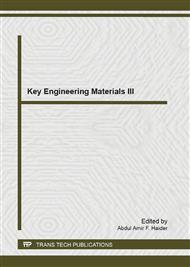p.370
p.375
p.378
p.382
p.389
p.394
p.399
p.403
p.408
Elemental Analysis and Wettability Properties of Polyene with Epoxidised Oil Based Coating
Abstract:
Presence of chlorine in by product of degradation process from polyvinyl chloride was analysed through structural feature changes and elemental analysis. Coating samples with polyene was also tested for its wettability via contact angle. Analyzing the elimination of chlorine content from polyvinylchloride through chemical dechlorination with tetrahydrofuran (THF) has been studied via FTIR spectra, energy-dispersive x-ray spectroscopy (EDS) and static contact angle measurement. Qualitative value of decreasing chlorine content of polyene at 2 hours reaction time was found to be about 96% from supplied PVC. All treated samples at different reaction time of polyene synthesize showed good wettability properties since the contact angle value were less than 90o.
Info:
Periodical:
Pages:
389-393
Citation:
Online since:
May 2013
Authors:
Keywords:
Price:
Сopyright:
© 2013 Trans Tech Publications Ltd. All Rights Reserved
Share:
Citation:


